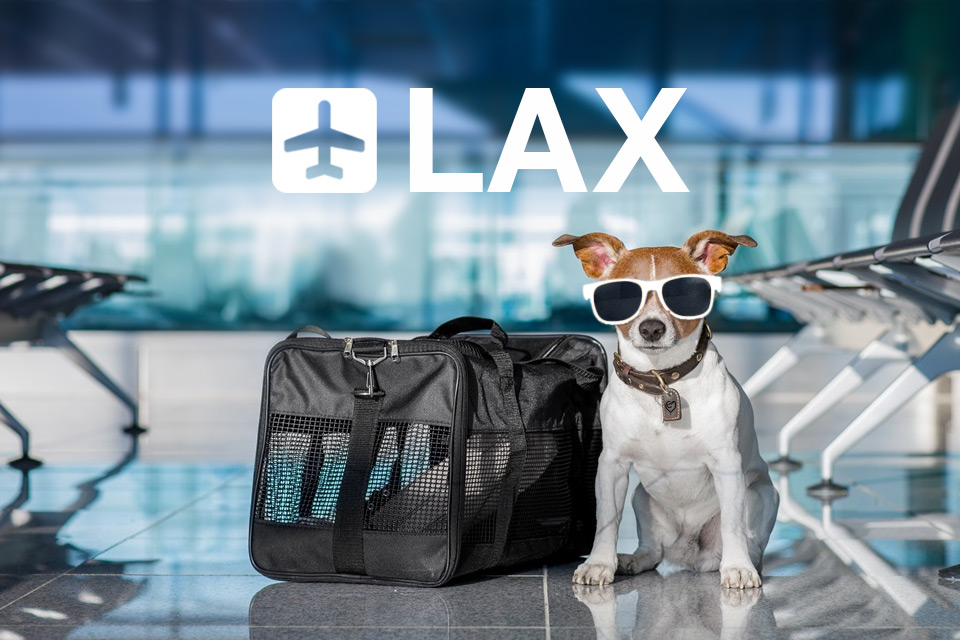
In total, there are 11 pet relief areas at Los Angeles International Airport (LAX)—8 inside the terminals and 3 outdoor pet parks. This large number of pet-friendly areas make LAX one of the best airports in the country for passengers who are traveling with their pets.
Near Arrivals on the lower level is where you will find the three outdoor areas, and you can use any of these before you go through security. They can be found between Terminals 1 and 2, Terminals 5 and 6, and at the end of Terminals 7 and 8.
Once you have gone through the security checkpoint, there are still the 9 indoor pet relief areas available for you to use—one in each terminal and one along the Tom Bradley International Terminal Bridge. They are located as follows:
Terminal 1 – Near Gate 13, behind California Pizza Kitchen and near the washrooms, there is a room designated as a pet relief area.

Terminal 2 – Once you pass through the security gate, you will find the pet relief room near Gate 21.

Terminal 3 – The outdoor atrium is the location for the pet relief area.

Terminal 4 – You will find the pet relief room along the TBIT.

Terminal 5 – Near Gate 52B is where you will find the pet relief room.

Terminal 6 – Near Gate 62, and close to the washrooms, the outdoor atrium contains a pet relief area.

Terminal 7 – As you get close to the Wolfgang Puck Express, you will find the pet relief room between Gate 73 and Gate 75B.

Terminal 8 – This is the only terminal that does not have its own indoor pet relief area. The closest place to take your pet is the outdoor dog park located at the east end of the terminal, or you may use the pet relief room in Terminal 7.
Tom Bradley International Terminal (TBIT) – As you come upon the entrance to the bridge that will take you to Terminal 4, the pet relief room is located just before the entrance.

Inside each of the designated pet areas, you will find everything that you need without any frills. There is plenty of fresh water, a dog waste station, and synthetic grass. To make your pet extra happy, there is also a fire hydrant! Although there should be waste removal bags available at every station, they occasionally run out, so it is always best to carry a couple of extra baggies with you.
While using the word “room” to describe the pet relief areas, you may get the impression that only a tiny space will be found behind the closed door. However, the rooms are quite large, but you cannot see this until you open the door. Keep in mind that many animals might need to use these facilities. Be patient if there is a line until it is your turn.

If your furbaby will not be allowed in the cabin with you, they will need to go to the designated cargo facility for your particular airline. These facilities are located on the grounds of the airport, but they are located away from the terminals. One of these facilities is at 5932 Century Blvd, and it houses United Airlines. The cargo facility for American Airlines is located at 5908 Avion Drive. Both Alaska Air and Delta Airlines’ cargo terminals can be found at 11101 Aviation Blvd. Virgin Atlantic is located at 5758 West Century Blvd.
Prior to 2016, Los Angeles International was one of the country’s worst airports for pet comfort, with only 4 pet relief stations. 7 were added in 2016, bringing the total to 11. These additions came during a time when LAX was concentrating on improving the entire airport experience and making the airport more pet and animal friendly. The pet relief areas are not just for household pets – it is common to see therapy dogs, law enforcement dogs, bomb-sniffing dogs, and service animals using these designated areas as well.
Along with h andling millions of travelers every year, LAX is also one of the world’s leading cargo airports. On-site, the cargo facilities encompass more than 2 million square feet. Although they are all located in the same basic area, it is a good idea to get specific directions when you book your pet on the plane.
Overall, LAX’s pet policies are comparable to many other airports. Pets must remain in their crates unless they are using the pet relief areas. The exception to this rule is service dogs.